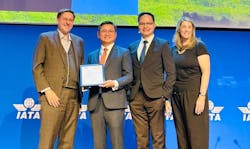In an effort to make ground operations safer, more efficient and cost effective, new technology solutions are being incorporated into ground support equipment (GSE) on an ongoing basis.
Officials at the International Air Transport Association (IATA) have highlighted a number of benefits of utilizing enhanced GSE and recognized success to further encourage the ground handling industry to adopt the latest technology.
As part of the 2024 IATA Ground Handling Conference (IGHC), IATA identified three key priorities for the ground handling market – improving safety through reduced operational risk; implementing global standards; and embedding sustainability in all activities.
In line with its safety objectives, IATA officials stated their intent to reduce ground damage through a transition to enhanced GSE.
“The aviation industry is facing a massive challenge. With the number of flights expected to rise, ground damage costs could reach $10 billion by 2035. A key mitigation measure is the adoption of enhanced GSE to make the ramp a safer place for both personnel and aircraft,” said Monika Mejstrikova, IATA’s director of ground operations. “This has the potential to reduce ground damage costs by 42 percent.”
During this year’s IGHC in Reykjavík, Iceland, IATA introduced its Enhanced GSE Recognition Program to encourage the use of upgraded GSE, such as equipment that uses anti-collision to improve a ground handling agent’s ability to control a vehicle and increase docking accuracy. IATA officials add that most enhanced GSE is electrically powered, thereby delivering sustainability gains over most non-enhanced GSE.
The program follows IATA Ground Damage Report: The Case for Enhanced Ground Support Equipment, which was published in 2022 and identified safety and sustainability benefits that could be gained from this transition.
According to IATA officials, ground handlers who integrate more enhanced GSE into their fleets above a set threshold will receive a two-year recognition stamp.
“It was quite challenging for us to find the right path and the right way to somehow accelerate the adoption of the ground support equipment that’s enhanced,” said Massimo Cicetti, head of innovation and efficiency at IATA.
However, through the program, he noted many consistent benefits were documented as a result of adopting enhanced GSE.
IATA ran pilot programs with three organizations to measure the effectiveness of enhanced GSE and encourage ground service providers to increase the use of enhanced GSE in their operations.
“We have been able to justify it and also test it in a real operation that this solution works,” Cicetti says. “Wherever the solution has been implemented so far, we have experienced no ground damage.”
First Recipients
Menzies Aviation and Hactl were the first ground handlers to complete IATA’s Enhanced GSE Recognition Program at various stations.
“The Enhanced GSE Recognition Program is another pillar of IATA's efforts to reduce ground damage by transitioning to Enhanced GSE fleets. The transition has been slow, despite well-documented gains in safety, cost-reduction and sustainability. By recognizing those companies leading the evolution, we aim to accelerate this critical industry transition,” said Mejstrikova.
The program allows participating ground handling service providers (GHSPs) to have their GSE fleets assessed. Following the assessment, those achieving a ratio of enhanced GSE to non-enhanced GSE that exceeds a predetermined threshold receive a recognition stamp valid for two years, according to IATA.
Participation in the program is voluntary and free of charge.
IATA presented Hactl and Menzies with a certificate of recognition at the IGHC.
“Hactl is totally committed to all measures that improve ramp safety, and has once again leveraged technology to protect its customers’ valuable assets,” said Paul Cheng, Hactl executive director – operations. “We are proud to be the first ground handler in Asia to achieve this distinction, and applaud IATA’s constant efforts in once again driving the adoption of best practice across the entire global aviation industry.”
IATA officials estimate that the annual cost of ground damage could reach $10 billion by 2035 unless preventive action is taken. According to IATA, however, transitioning 75 percent of the global fleet of belt loaders, cargo loaders, passenger stairs and passenger boarding bridges to enhanced GSE, could reduce the current expected ground damage cost per turn rate by 42 percent.
IATA officials point out the IATA Airport Handling Manual (AHM) identifies the design and use of enhanced GSE as a best practice. IATA’s Enhanced GSE Recognition Program is designed to complement the IATA Safety Audit for Ground Operations (ISAGO). ISAGO will include the integration of enhanced GSE into operations as of 2025.
IATA officials say the new program will be deployed in several phases. It will initially focus on assessing the three types of GSE most associated with ground damage incidents: belt loaders, ULD loaders and passenger stairs.
After the initial phase, IATA intends to expand the program to include lifting and elevating GSE units that dock at aircraft doors as well as GSE that couples to aircraft.
About the Author
Josh Smith
Editor
Josh Smith served as editor of Ground Support Worldwide as editor from 2016 through 2024. He oversaw production of the print magazine, created GSW's newsletters on a daily basis, and updated the latest news on AviationPros.com.

